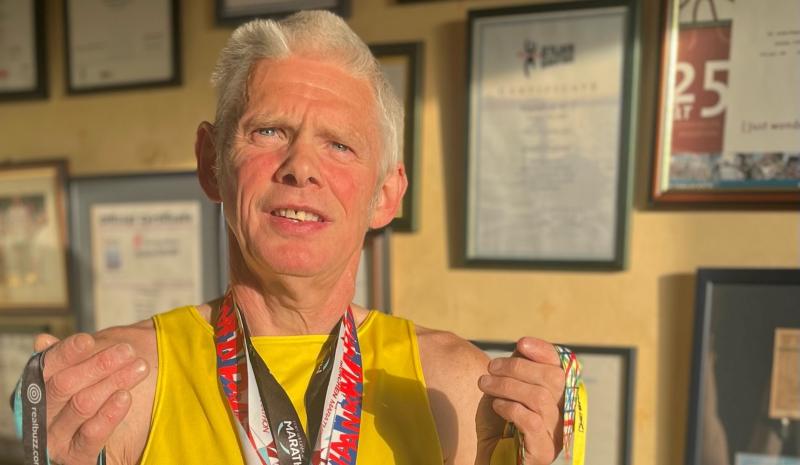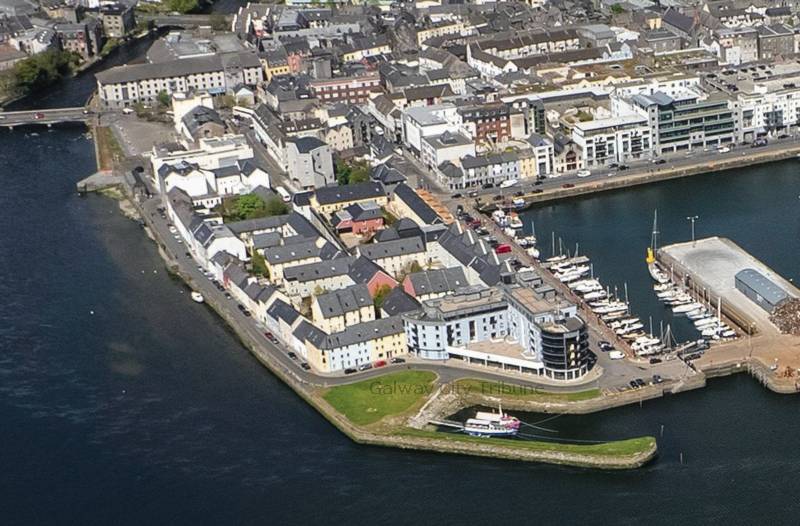News
Teenage hurlers hit by meningitis

Two minor hurlers from the Oranmore area were hospitalised with a suspected meningitis infection.
Two of the teenagers – who were recently crowned minor B county champions – were diagnosed with meningitis last week.
In a post on the Facebook Page of the Oranmore Maree GAA Club, the management outlined that due to the fast actions of their parents, both boys will fully recover.
“They will be alright, both are still in University Hospital Galway and we thank the staff at the hospital for the wonderful care they are receiving,” according to a post on the Facebook Page of the Oranmore Maree GAA Club.
“We urge everyone and in particular parents to monitor and be aware of the symptoms of meningitis and to not hesitate seeking professional medical advice as meningitis can be fatal if not caught in time. Speedy recovery to the lads.”
One of the hurlers was the captain of the victorious team, Sean Bannon, who just a week before lifted the minor cup for his hometown after beating Killimordaly in a replay, the first time in 30 years that it had been claimed in Maree/Oranmore.
His brother Alan told Galway Bay FM that Sean came down with a ferocious headache and was laid up in bed.
Eight hours later, the headache was getting worse instead of better, and his mother Anne decided to take him to Westdoc, who immediately referred him to the emergency department at University Hospital Galway (UHG).
He didn’t show any of the tell-tale signs, he had no rash, no stiffness in the neck and he had no sensitivity to lights. They caught it in time,” Alan recalled.
Once a lumbar puncture and other tests confirmed the presence of viral meningitis, he was immediately put on a drip and an aggressive regime of antibiotics.
Word of his illness spread so that when another team mate came down with similar symptoms, his parents rushed him to casualty where he was immediately diagnosed with the same thing and put on a drip.
In July a 23-year-old Derry footballer passed away from meningitis. Alan said they were grateful both boys were caught early.
“Hours and minutes make all the difference,” he reflected.
Following the outbreak, other members of the team reported feeling similar symptoms but so far no other cases have been confirmed, according to a spokesman for the Health Service Executive (HSE).
“The Public Health Department did have reports about a few kids complaining of headaches but they were not diagnosed with meningitis,” he said.
Meningitis is where a viral or bacterial infection causes inflammation of the lining around the spinal cord and the brain.
Meningitis is usually viral or bacterial. Viral meningitis is a serious illness, but doesn’t usually end in fatality and most people make a full recovery. Bacterial has a higher incidence of fatality and has many strains, caused by many different bacteria. Most of the cases in Ireland are caused by meningococcal disease.
Siobhán Carroll, of the support group Act for Meningitis, said it was most unusual for an outbreak to claim two victims in the one area. She had also heard there were a number of other cases in the Oranmore area but tests had not confirmed the presence of the virus.
“It would be extremely rare to have that many cases a few days apart. We only hear from families dealing with their own cases who are calling for support – never about this many,” she explained.
Meningitis is the biggest killer of children under five in Ireland. One in ten people who contract meningitis will die, one in five will be left with severe after affects.
“There is a higher risk of meningitis during the winter months. As people spend a lot more time indoors and with close contact, germs are spread more easily. Also, coming down with a ‘cold’ or the ‘flu’, may weaken the immune system making you more susceptible to the disease.”
The symptoms may be difficult to spot as many of the early symptoms can be similar to those of the ‘flu’. The charity urges people trust their instincts and if they suspect meningitis, seek medical help immediately.
The signs of Meningitis can include vomiting, fever, headache, stiff neck, dislike of bright lights, severe muscle pain, confusion.
In babies among the symptoms are being irritable, refusing to feed, high pitched crying, rapid breathing and cold hands and feet and a bulging soft spot on head.
Children up to age five are the most at-risk age group, young people aged 16-24 are the second highest at-risk group but anyone of any age can contract meningitis.
Meningitis does not always produce a rash but if it does appear it will not fade under pressure, even if a drinking glass is applied over it, which is known as the tumbler test.
“Time is of the utmost importance. Meningitis can strike so quickly and can kill within hours,” warned Siobhán.
ACT for Meningitis provide a wide range of free support service to those affected, and currently support families and individuals in 15 counties.
Connacht Tribune
West has lower cancer survival rates than rest

Significant state investment is required to address ‘shocking’ inequalities that leave cancer patients in the West at greater risk of succumbing to the disease.
A meeting of Regional Health Forum West heard that survival rates for breast, lung and colorectal cancers than the national average, and with the most deprived quintile of the population, the West’s residents faced poorer outcomes from a cancer diagnosis.
For breast cancer patients, the five-year survival rate was 80% in the West versus 85% nationally; for lung cancer patients it was 16.7% in the west against a 19.5% national survival rate; and in the West’s colorectal cancer patients, there was a 62.6% survival rate where the national average was 63.1%.
These startling statistics were provided in answer to a question from Ballinasloe-based Cllr Evelyn Parsons (Ind) who said it was yet another reminder that cancer treatment infrastructure in the West was in dire need of improvement.
“The situation is pretty stark. In the Western Regional Health Forum area, we have the highest incidence of deprivation and the highest health inequalities because of that – we have the highest incidences of cancer nationally because of that,” said Cllr Parsons, who is also a general practitioner.
In details provided by CEO of Saolta Health Care Group, which operates Galway’s hospitals, it was stated that a number of factors were impacting on patient outcomes.
Get the full story in this week’s Connacht Tribune, on sale in shops now, or you can download the digital edition from www.connachttribune.ie. You can also download our Connacht Tribune App from Apple’s App Store or get the Android Version from Google Play.
Connacht Tribune
Marathon Man plans to call a halt – but not before he hits 160 races

On the eve of completing his 150th marathon, an odyssey that has taken him across 53 countries, Loughrea’s Marathon Man has announced that he is planning to hang up his running shoes.
But not before Jarlath Fitzgerald completes another ten races, making it 160 marathons on the occasion of his 60th birthday.
“I want to draw the line in 2026. I turn 57 in October and when I reach 60 it’s the finishing line. The longer races are taking it out of me. I did 20 miles there two weeks ago and didn’t feel good. It’s getting harder,” he reveals.
“I’ve arthritis in both hips and there’s wear and tear in the knees.”
We speak as he is about to head out for a run before his shift in Supervalu Loughrea. Despite his physical complaints, he still clocks up 30 miles every second week and generally runs four days a week.
Jarlath receives injections to his left hip to keep the pain at bay while running on the road.
To give his joints a break, during the winter he runs cross country and often does a five-mile trek around Kylebrack Wood.
He is planning on running his 150th marathon in Cork on June 4, where a group of 20 made up of work colleagues, friends and running mates from Loughrea Athletics Club will join him.
Some are doing the 10k, others are doing the half marathon, but all will be there on the finishing line to cheer him on in the phenomenal achievement.
Get the full story in this week’s Connacht Tribune, on sale in shops now, or you can download the digital edition from www.connachttribune.ie. You can also download our Connacht Tribune App from Apple’s App Store or get the Android Version from Google Play.
CITY TRIBUNE
Galway ‘masterplan’ needed to tackle housing and transport crises

From the Galway City Tribune – An impassioned plea for a ‘masterplan’ that would guide Galway City into the future has been made in the Dáil. Galway West TD Catherine Connolly stated this week that there needed to be an all-inclusive approach with “vision and leadership” in order to build a sustainable city.
Deputy Connolly spoke at length at the crisis surrounding traffic and housing in Galway city and said that not all of the blame could be laid at the door of the local authority.
She said that her preference would be the provision of light rail as the main form of public transport, but that this would have to be driven by the government.
“I sat on the local council for 17 years and despaired at all of the solutions going down one road, metaphorically and literally. In 2005 we put Park & Ride into the development plan, but that has not been rolled out. A 2016 transport strategy was outdated at the time and still has not been updated.
“Due to the housing crisis in the city, a task force was set up in 2019. Not a single report or analysis has been published on the cause of the crisis,” added Deputy Connolly.
She then referred to a report from the Land Development Agency (LDA) that identified lands suitable for the provision of housing. But she said that two-thirds of these had significant problems and a large portion was in Merlin Park University Hospital which, she said, would never have housing built on it.
In response, Minister Simon Harris spoke of the continuing job investment in the city and also in higher education, which is his portfolio.
But turning his attention to traffic congestion, he accepted that there were “real issues” when it came to transport, mobility and accessibility around Galway.
“We share the view that we need a Park & Ride facility and I understand there are also Bus Connects plans.
“I also suggest that the City Council reflect on her comments. I am proud to be in a Government that is providing unparalleled levels of investment to local authorities and unparalleled opportunities for local authorities to draw down,” he said.
Then Minister Harris referred to the controversial Galway City Outer Ring Road which he said was “struck down by An Bord Pleanála”, despite a lot of energy having been put into that project.
However, Deputy Connolly picked up on this and pointed out that An Bord Pleanála did not say ‘No’ to the ring road.
“The High Court said ‘No’ to the ring road because An Bord Pleanála acknowledged it failed utterly to consider climate change and our climate change obligations.
“That tells us something about An Bord Pleanála and the management that submitted such a plan.”
In the end, Minister Harris agreed that there needed to be a masterplan for Galway City.
“I suggest it is for the local authority to come up with a vision and then work with the Government to try to fund and implement that.”












